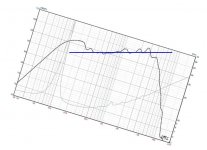Hello,
Regardless of the shortcomings, it sounds like you are having a lot of fun with those drivers, and that's of course the most important thing above all
What was your cross-over freq and slope again for that driver?
I was intending to stay below about 1.5kHz to avoid the worst breakups, and use active crossing 4th order slope. For that freq range I'd like to believe there can be a reasonable low price high efficiency driver available, I don't mind if somebody call it a guitar driver
I think the reason for poor behaviour is partly because of the straight cone profile of guitar drivers. Interesting to compare the cone profile to any 8" and bigger full range hifi drivers which almost all have curved profiles. Clearly they do straight cones intentionally for their own interests (damn them ).
).
- Elias
CLS said:I think the major 'problems' of guitar drivers are those not-so-controlled (or specifically controlled) cone breakups in the mid-high frequencies. With the not-low-enough voice coil inductance, rising impedance, and the cone full of breakups, the sound in this frenquency range is almost produced by cone breakups and not properly driven by motor!
Regardless of the shortcomings, it sounds like you are having a lot of fun with those drivers, and that's of course the most important thing above all
What was your cross-over freq and slope again for that driver?
I was intending to stay below about 1.5kHz to avoid the worst breakups, and use active crossing 4th order slope. For that freq range I'd like to believe there can be a reasonable low price high efficiency driver available, I don't mind if somebody call it a guitar driver
I think the reason for poor behaviour is partly because of the straight cone profile of guitar drivers. Interesting to compare the cone profile to any 8" and bigger full range hifi drivers which almost all have curved profiles. Clearly they do straight cones intentionally for their own interests (damn them
- Elias
Elias said:An externally hosted image should be here but it was not working when we last tested it.
I just love that looks
http://www.eminence.com/pdf/legend-1028k.pdf
10dB mid peak is evil for HiFi though
Fun? Yes, of course! 
The afore-mentioned Legend 125 was used as center channel for a while. Back then the driver was not treated by any means, so that midhigh breakup was clearly audible. Those ts~ ch~ z~ voices and picks of strings in concert DVD were emphasized, which can be intrusive sometimes (depends on your mood...).
Now the drivers have been modded and the breakups are largely damped. So I didn't avoid that frequency range on xover and still use them up to 3kHz (12dB/oct). This is quite high for a 12"er by any standard. And they sing beautifully! Mr. Oistrakh is playing Beethoven's Sonata in my living room right now The sound is very lively and vivid. For a pair of cheap 'guitar' drivers, it's just amazing! Compared with other 'normal' drivers, I think it's overall performance in this application is still very good.
The sound is very lively and vivid. For a pair of cheap 'guitar' drivers, it's just amazing! Compared with other 'normal' drivers, I think it's overall performance in this application is still very good.
The straight cone prolfile might be a double sided sword. I like its directness and dynamics. However the breakups must be controlled for hi-fi use. The corrugated press might help a little. And my later PVA glue treatment and phase plug give furthur improvement. (which can be proved by impedance scan and RTA measurement)
In my application, I don't worry about the Xmax at all. 12" midrange is just so loud with so little moves. With the help of 160Hz high pass, I think I won't have any chance to use up the 0.5mm Xmax.
By this I also found an interesting thing when I cut the dust cap -- I have to push the cone forward (from the back) by about 3~4mm to see the voice coil protruding the pole piece. From the thickness of top plate, it's impossible to be an under hung motor (and by that large of travel). I'm wondering whether the voice coil is un-aligned or the center pole piece is higher than the top plate. I can not disassemble the whole driver to examine this.
A similar condition appears on my 18" woofer of the same brand. The voice coil protrudes the pole piece by only about 1mm. And the published datasheet shows 6mm of Xmax. I can't tell whether it's bad alignment or the long pole.
------------------
Here are some pictures for your reference:
The modded driver:


The cuts on paper surround:

These cuts brought the fs from 110Hz down to 90Hz. But the Q was barely affected. The overall stiffness of suspension is soften somewhat (tested by hand) but still sort of stiff... And the midbass leaks from these slots so I need about +3dB EQ in the range of 200~350Hz. I'll work on this area in the near future....
The very crude initial setup, just tucked on the original baffle hole for 8" from the back. So the outer area was covered and a cavity was formed, just like a 'compression chamber', haha....
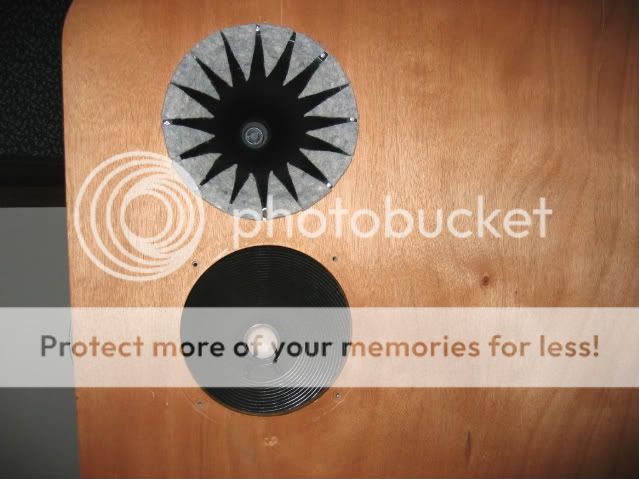

The 'improved' version of baffle cut -- enlarged to proper size and chamfered.

Overall view now.

Any comments are welcome.
The afore-mentioned Legend 125 was used as center channel for a while. Back then the driver was not treated by any means, so that midhigh breakup was clearly audible. Those ts~ ch~ z~ voices and picks of strings in concert DVD were emphasized, which can be intrusive sometimes (depends on your mood...).
Now the drivers have been modded and the breakups are largely damped. So I didn't avoid that frequency range on xover and still use them up to 3kHz (12dB/oct). This is quite high for a 12"er by any standard. And they sing beautifully! Mr. Oistrakh is playing Beethoven's Sonata in my living room right now
The straight cone prolfile might be a double sided sword. I like its directness and dynamics. However the breakups must be controlled for hi-fi use. The corrugated press might help a little. And my later PVA glue treatment and phase plug give furthur improvement. (which can be proved by impedance scan and RTA measurement)
In my application, I don't worry about the Xmax at all. 12" midrange is just so loud with so little moves. With the help of 160Hz high pass, I think I won't have any chance to use up the 0.5mm Xmax.
By this I also found an interesting thing when I cut the dust cap -- I have to push the cone forward (from the back) by about 3~4mm to see the voice coil protruding the pole piece. From the thickness of top plate, it's impossible to be an under hung motor (and by that large of travel). I'm wondering whether the voice coil is un-aligned or the center pole piece is higher than the top plate. I can not disassemble the whole driver to examine this.
A similar condition appears on my 18" woofer of the same brand. The voice coil protrudes the pole piece by only about 1mm. And the published datasheet shows 6mm of Xmax. I can't tell whether it's bad alignment or the long pole.
------------------
Here are some pictures for your reference:
The modded driver:


The cuts on paper surround:

These cuts brought the fs from 110Hz down to 90Hz. But the Q was barely affected. The overall stiffness of suspension is soften somewhat (tested by hand) but still sort of stiff... And the midbass leaks from these slots so I need about +3dB EQ in the range of 200~350Hz. I'll work on this area in the near future....
The very crude initial setup, just tucked on the original baffle hole for 8" from the back. So the outer area was covered and a cavity was formed, just like a 'compression chamber', haha....


The 'improved' version of baffle cut -- enlarged to proper size and chamfered.

Overall view now.

Any comments are welcome.
Hello,
How about now?
100-200Hz peak is used for dipole compensation.
- Elias
Geek said:10dB mid peak is evil for HiFi though
How about now?
100-200Hz peak is used for dipole compensation.
- Elias
Attachments
Elias said:How about now?
An externally hosted image should be here but it was not working when we last tested it.
I'll buy one!
There are enthusiasts who believe the benefits from the paper voice coil former of old drivers are significant
Lowther, Supravox and PHY use, and maybe others like Fertin and EMS use paper former
Notice that Eminence Legend alnico is available in a lower 20watt version with paper voice coil former
As fore the peak
Even the most popular have peaks, often much sharper and worse
And even the best driver with apparently no peaks may still need notch filter
Lowther, Supravox and PHY use, and maybe others like Fertin and EMS use paper former
Notice that Eminence Legend alnico is available in a lower 20watt version with paper voice coil former
As fore the peak
Even the most popular have peaks, often much sharper and worse
And even the best driver with apparently no peaks may still need notch filter
Hello,
I think 3kHz is quite high for any 12" driver, be it hifi, PA or guitar driver. At 3kHz many of the smaller 8" and even 6" drivers are losing it's performance. Time domain transient waveforms look horrible. It's interesting though what is the impact to the sound however. Lucky our ears are not oscilloscopes. As you say, it sounds like it is enjoyable even at 3kHz. What else is needed? When you know the cheap price of the driver it sounds even better
I didn't catch if you use active or passive cross over?
Dipoles rules! The baffle is reasonably big I think. It's bigger than I ever tried, instead I use more dipole correction in equalizer.
I see you have some tube gear on the pics. I think you are using these elements in just the way they should be used
Have you tried applying DC bias on the element for experimenting of active realignment? That could be fun too, don't you think?
- Elias
CLS said:Now the drivers have been modded and the breakups are largely damped. So I didn't avoid that frequency range on xover and still use them up to 3kHz (12dB/oct). This is quite high for a 12"er by any standard. And they sing beautifully!
Mr. Oistrakh is playing Beethoven's Sonata in my living room right nowThe sound is very lively and vivid. For a pair of cheap 'guitar' drivers, it's just amazing! Compared with other 'normal' drivers, I think it's overall performance in this application is still very good.
I think 3kHz is quite high for any 12" driver, be it hifi, PA or guitar driver. At 3kHz many of the smaller 8" and even 6" drivers are losing it's performance. Time domain transient waveforms look horrible. It's interesting though what is the impact to the sound however. Lucky our ears are not oscilloscopes. As you say, it sounds like it is enjoyable even at 3kHz. What else is needed? When you know the cheap price of the driver it sounds even better
I didn't catch if you use active or passive cross over?
Dipoles rules! The baffle is reasonably big I think. It's bigger than I ever tried, instead I use more dipole correction in equalizer.
I see you have some tube gear on the pics. I think you are using these elements in just the way they should be used
By this I also found an interesting thing when I cut the dust cap -- ...
I can't tell whether it's bad alignment or the long pole.
Have you tried applying DC bias on the element for experimenting of active realignment? That could be fun too, don't you think?
- Elias
Hi,
According to the datasheet, the driver itself can play up to about 5kHz. As I see the FR chart, it drops like a stone after 4k, though. Well, maybe those above 1.5kHz are all rubbish anyway. I don't know.
The straight cone is pretty stiff by itself. And the PVA glue treatment made quite a lot of influence on it (much more than other 'normal drivers' I tried). From very intrusive to enjoyable, I think that is a big change. I will keep modifying this driver and see how far it can go....
A 12"er does beam when playing up to 3kHz. Off-axis performance is not as good as the 8" one I previously used. However on the dipole configuration, in room response is still pretty good. I often listen to them by my dinning table which is at the right side of the right channel. It can not be a proper listening position but the sound is still good.
DC bias to the voice coil is new to me and seems very interesting. However, before I know the exact correct alignment, it sounds like shooting in the dark.
According to the datasheet, the driver itself can play up to about 5kHz. As I see the FR chart, it drops like a stone after 4k, though. Well, maybe those above 1.5kHz are all rubbish anyway. I don't know.
The straight cone is pretty stiff by itself. And the PVA glue treatment made quite a lot of influence on it (much more than other 'normal drivers' I tried). From very intrusive to enjoyable, I think that is a big change. I will keep modifying this driver and see how far it can go....
A 12"er does beam when playing up to 3kHz. Off-axis performance is not as good as the 8" one I previously used. However on the dipole configuration, in room response is still pretty good. I often listen to them by my dinning table which is at the right side of the right channel. It can not be a proper listening position but the sound is still good.
DC bias to the voice coil is new to me and seems very interesting. However, before I know the exact correct alignment, it sounds like shooting in the dark.
Oh, forgot to mention that the xover is passive 2nd order between mid and high, active 1st order between mid and low.
Pre and active xover are made as one, using 5842 and OPT for each channel (total 4 of them). Amp for mid-high is choke loaded 6J5 driver with 6H30 output, only about 1W output. Amp for woofer is now SS (cheap and good old Hafler) -- the T-bass circuit I use in bass section need low output impedance.
The old tuby stuff you saw on the bottom of equipment rack is Altec 1568 which is not used for the time being.
Pre and active xover are made as one, using 5842 and OPT for each channel (total 4 of them). Amp for mid-high is choke loaded 6J5 driver with 6H30 output, only about 1W output. Amp for woofer is now SS (cheap and good old Hafler) -- the T-bass circuit I use in bass section need low output impedance.
The old tuby stuff you saw on the bottom of equipment rack is Altec 1568 which is not used for the time being.
Some more info and updates
I made some more mods on the drivers last night. I re-sealed the slot-cutting on surround by glue and made 3 fan-shape cuts on the spider.


I've not yet auditioned the result, but some quick impedance scans were made. Together with the previous measurements, here are the comparisons:
This is the raw driver with dust cap removed:
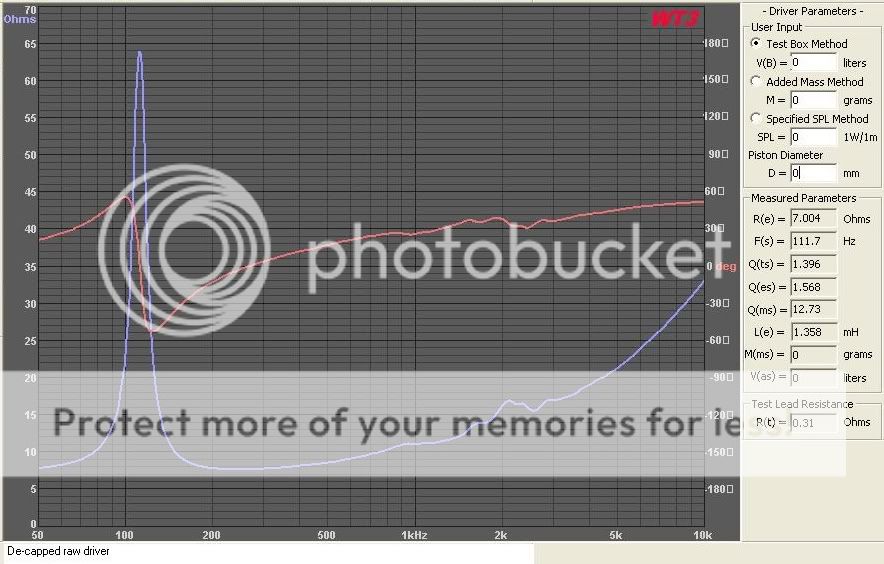
This is with slot-cutting on the surround:
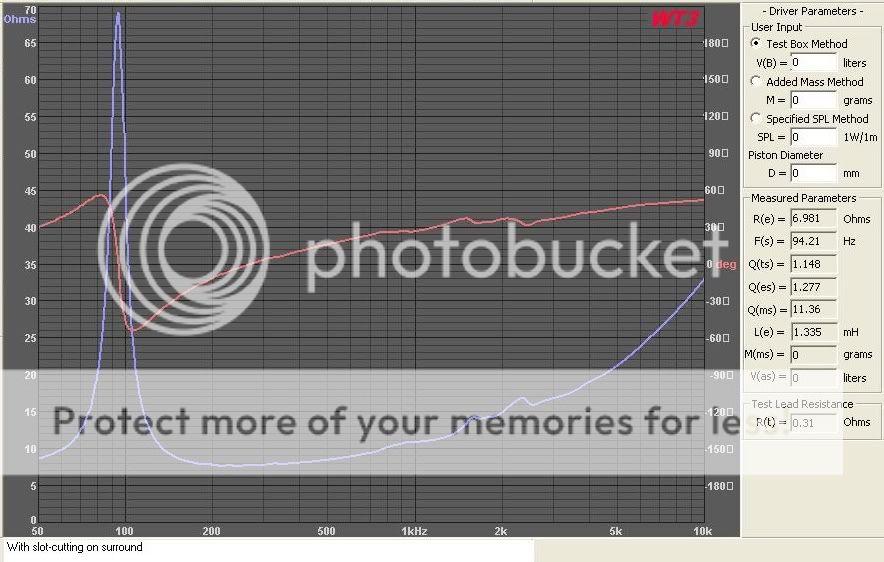
(the impedance peak are lowered and split)
This is with surround cut and PVA treatment on cone:

(the 2 impedance peaks are further suppressed)
This is with re-seal of surround's cut and cutting on spider:
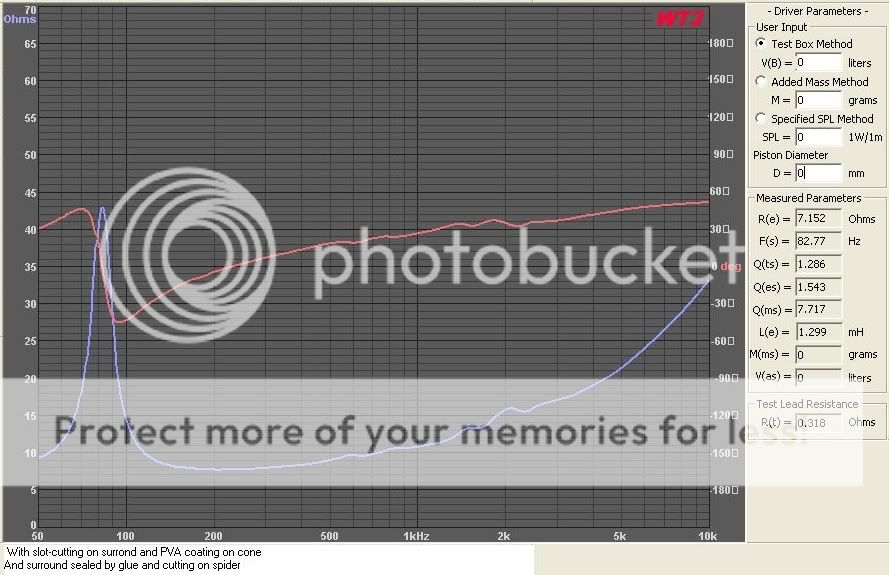
For your reference.
I made some more mods on the drivers last night. I re-sealed the slot-cutting on surround by glue and made 3 fan-shape cuts on the spider.


I've not yet auditioned the result, but some quick impedance scans were made. Together with the previous measurements, here are the comparisons:
This is the raw driver with dust cap removed:

This is with slot-cutting on the surround:

(the impedance peak are lowered and split)
This is with surround cut and PVA treatment on cone:

(the 2 impedance peaks are further suppressed)
This is with re-seal of surround's cut and cutting on spider:

For your reference.
Hi,
On this driver, I found the overall stiffness of suspension is dominated by the paper surround, which is the same piece of material of the cone. While the spider is relatively quite soft.
So the cuts on spider didn't afftect the overall stiffness very much. Together with the cut and glue-sealed surround, they lowered the fs a little anyway.
The current status is:
1. De-capped and PVA coating on cone
2. Surround is cut and re-sealed by glue
3. Spider is cut
I found the most significant change is brought by the glue-treatment on surround. It sealed the cut slots and saved the loss on lower mid and also suppress the peaks on mid high very much.
Previously this driver sounds somewhat edgy. With PVA coating and cuts on surround, the mid high peaks were lowered by some extent, but still sort of 'snapy' and needs some EQ to be reasonably flat. With glue on surround, the sound turned into mellow and warm.
Funny, I think I overdid the damping. Even with re-adjustment on EQ (now it's almost flat in the range by itself), the original senses of energetic and vivid are largely muffled. I'll need to do something to bring them back in the near future.....
And I also found the side effect of cutting on the spider -- the cone movement is not so 'straight' as before. I mean, when being pushed on the edge, the cone used to move back and forth as a whole (well, mostly). Now it would tilt somewhat and the opposite side of cone which is not pushed moves very little. Pushing it further, eventually the voice coil would rub on the gap.
Maybe, in the frequency range I'm using it, coil rocking is not much to worry. But I guess the 'proportion' of compliances of spider and surround changes somehow. Now the surround provides even more resistance and damping, so the cone might 'distort' earlier, thus changes the whole sound character....
More to come (maybe)....
On this driver, I found the overall stiffness of suspension is dominated by the paper surround, which is the same piece of material of the cone. While the spider is relatively quite soft.
So the cuts on spider didn't afftect the overall stiffness very much. Together with the cut and glue-sealed surround, they lowered the fs a little anyway.
The current status is:
1. De-capped and PVA coating on cone
2. Surround is cut and re-sealed by glue
3. Spider is cut
I found the most significant change is brought by the glue-treatment on surround. It sealed the cut slots and saved the loss on lower mid and also suppress the peaks on mid high very much.
Previously this driver sounds somewhat edgy. With PVA coating and cuts on surround, the mid high peaks were lowered by some extent, but still sort of 'snapy' and needs some EQ to be reasonably flat. With glue on surround, the sound turned into mellow and warm.
Funny, I think I overdid the damping. Even with re-adjustment on EQ (now it's almost flat in the range by itself), the original senses of energetic and vivid are largely muffled. I'll need to do something to bring them back in the near future.....
And I also found the side effect of cutting on the spider -- the cone movement is not so 'straight' as before. I mean, when being pushed on the edge, the cone used to move back and forth as a whole (well, mostly). Now it would tilt somewhat and the opposite side of cone which is not pushed moves very little. Pushing it further, eventually the voice coil would rub on the gap.
Maybe, in the frequency range I'm using it, coil rocking is not much to worry. But I guess the 'proportion' of compliances of spider and surround changes somehow. Now the surround provides even more resistance and damping, so the cone might 'distort' earlier, thus changes the whole sound character....
More to come (maybe)....
I think you shouldn't have cut the spider. that new wiggle at 600hz is probably caused by spider's nonlinearity. I've seen scanspeak woofer mod, where spider was replaced with thread, woven around speakers frame and cone (can't find webpage now)
since spider is already ruined, you may try that thread mod too, if it fails you can always convert this woofer to passive radiator
since spider is already ruined, you may try that thread mod too, if it fails you can always convert this woofer to passive radiator
Passive radiator? No! 
It's too stiff and too short in travel anyway.
Luckily, the 600Hz bump in impedance plot shows little effect in the frequency response. That slightly increased and broaden 2kHz peak is also absent on both RTA and listening. Strange but true.
I will see what I can do with the spider. I've seen 'string' spider mod, too. Fixing points and the adjustment of tension might be the problem....

It's too stiff and too short in travel anyway.
Luckily, the 600Hz bump in impedance plot shows little effect in the frequency response. That slightly increased and broaden 2kHz peak is also absent on both RTA and listening. Strange but true.
I will see what I can do with the spider. I've seen 'string' spider mod, too. Fixing points and the adjustment of tension might be the problem....
CLS said:
I've seen 'string' spider mod, too. Fixing points and the adjustment of tension might be the problem....
Its no problem if you mount strings/threads so that they just touches the voicecoil...and apply glue at the voice coil as the last move
With proper and equal tension it will last a very long time
Mount a little wood at the chassis, fore the threads
If dustcap is removed you can stick paper between voicecoil and poleplate
If you dont remove dustcap its possible to stick thinn metal threads through the dustcap and into magnet gap
Hi tinitus,
Thanks for the good tips. Will do.
But I can't follow the 2 methods about dust cap. The caps on my drivers are removed anyway. And I inserted a phase plug in the hole, so it seems no space for that...
Hi gainphile,
It's actually not that bad. I often listen to them far off axis -- almost at the side. It seems not a good idea for a pair of OB speaker, but it's no problem maintaining very good tonal balance In such listing position, only the quantity of bass is slightly reduced, no big deal. The sound is always filling the room and evenly spread everywhere in the home -- no that kind of "boom in next room" effect thanks to dipole.
In such listing position, only the quantity of bass is slightly reduced, no big deal. The sound is always filling the room and evenly spread everywhere in the home -- no that kind of "boom in next room" effect thanks to dipole.
I guess 2 things help: 1 is the cone is far from ideal piston, so the 'effective' area would be far smaller (and the phase plug might help a little here). 2 is on the open baffle, the 'beamwidth' of mid to lower mid is also relatively narrow, so the beaming at higher frequency might not be so obvious.
Thanks for the good tips. Will do.
But I can't follow the 2 methods about dust cap. The caps on my drivers are removed anyway. And I inserted a phase plug in the hole, so it seems no space for that...
Hi gainphile,
It's actually not that bad. I often listen to them far off axis -- almost at the side. It seems not a good idea for a pair of OB speaker, but it's no problem maintaining very good tonal balance
I guess 2 things help: 1 is the cone is far from ideal piston, so the 'effective' area would be far smaller (and the phase plug might help a little here). 2 is on the open baffle, the 'beamwidth' of mid to lower mid is also relatively narrow, so the beaming at higher frequency might not be so obvious.
CLS said:
Thanks for the good tips. Will do.
But I can't follow the 2 methods about dust cap.
.
With the spider removed it should be possible to insert paper into magnet gap, from behind the cone...just makes sure you bend the pieces of paper to secure it, and being out of the way when mounting threads
- Status
- This old topic is closed. If you want to reopen this topic, contact a moderator using the "Report Post" button.
- Home
- Loudspeakers
- Multi-Way
- Using 12" guitar element as high efficiency midrange?
